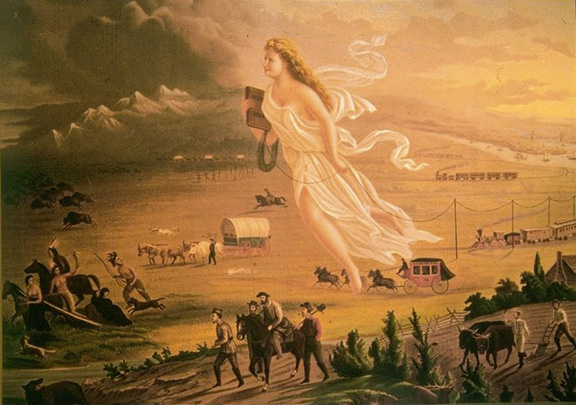
Manifest Destiny

American Progress (1872)
John Gast
In John Gast's "American Progress," (1872) a diaphanously and precarious clad America floats westward thru the air with the "Star of Empire" on her forehead. She has left the cities of the east behind, and the wide Mississippi, and still her course is westward. In her right hand she carries a school book - testimonial of the national enlightenment, while with her left she trails the slender wires of the telegraph that will bind the nation. Fleeing her approach are Indians, buffalo, wild horses, bears and other game, disappearing into the storm and waves of the Pacific coast. They flee the wonderous vision - the star "is too much for them." - George Crofutt (a contemporary of Gast, who engraved and distributed this painting widely)
The term “Manifest Destiny” appeared in print on September 15, 1845, when John L. O’Sullivan wrote in the New York Herald:
It was the fulfillment of our manifest destiny to overspread the continent allotted by Providence for the free development of our yearly multiplying millions. No longer bounded by the limits of the confederacy, it looks abroad upon the whole earth, and into the mind of the republic daily sinks deeper and deeper the conviction that civilization on the earth—the reform of the governments of the ancient world—the emancipation of the whole race, are dependent, in a great degree, on the United States.
William Weeks, in Building the Continental Empire (1996), contends that the origins of Manifest Destiny can be found in the Puritan era, when John Winthrop sermonized that the Massachusetts Bay Colony represented a “shining city upon a hill” from whence the regeneration of the world might proceed. Weeks suggests that "by the eighteenth century the European enlightenment viewed America as a special place where human society might begin anew, uncorrupted by Old World institutions and ideas.” Thomas Jefferson saw the movement west as necessary for the perpetuation of an “Empire of Liberty.” John Quincy Adams said that expansion across the North American continent was “as much the law of nature as that the Mississippi should flow to the sea.”
Sam W. Hayes at the University of Texas notes: "The 1840s were years of extraordinary territorial growth for the united States. During a four year period, the national domain increased by 1.2 million square miles, a gain of more than sixty percent. So rapid and dramatic was the process of territorial expansion, that it came to be seen as an inexorable process, prompting many Americans to insist that their nation had a "manifest destiny" to dominate the continent.
Yet, the expansionist agenda was never a clearly defined movement, or one that enjoyed broad, bipartisan support. Whig party leaders vigorously opposed territorial growth, and even expansionist Democrats argued about how much new land should be acquired, and by what means."